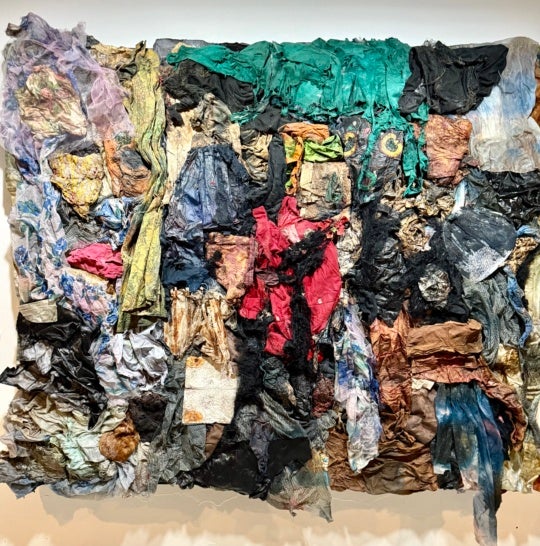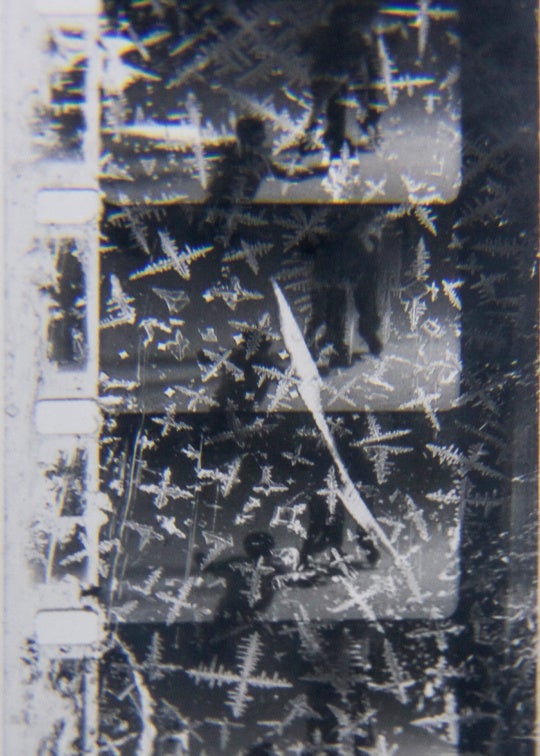
silver print, signed, titled and dated verso in pencil, courtesy Jackson Fine Art, Atlanta
Jackson Fine Art Gallery’s current exhibitions, North, South, East, West by Richard Benson and Photographs by Emmet Gowin, continue the gallery’s mission to represent a mix of internationally recognized photographers [April 19-July 27, 2013]. Richard Benson and Emmet Gowin are both white males who spent their careers in Ivy League institutions in the American Northeast—Benson at Yale and Gowin at Princeton. Instead of a blended two-person exhibition, the gallery space is divided into two solo shows, with separate spaces dedicated to Benson’s technical mastery and Gowin’s romantic imagery.
Emmet Gowin’s photographs, in the front rooms, are drawn from a long personal history—60 plus years—photographing his immediate family and landscapes. There are four images (from different eras) of Edith, Gowin’s wife and muse. Edith, Chincoteague, Virginia (1967), exemplifies Gowin’s interest in the expressive body and landscape space. Edith is photographed from behind and slightly aerial: It’s a perspective that evokes trust and protectiveness, though her shoulders are drawn back sharply with quiet independence. Gowin’s lens directed on her back is as simultaneously tender and distant as the assumed body of water that she gazes into. Opposingly, Edith, Danville, Virginia (1967), depicts Edith not only as photographer’s muse or wife, but as a strong individual. Though her body is exposed, the viewer ultimately becomes unmasked, and Gowin clearly savors her direct eye contact. The arch of her eyebrow and sway of her body are confident and confrontational, while her delicate frame blocks the open doorway. It serves as both portrait of Edith and of their young partnership. It’s worth noting that Gowin studied at RISD with Harry Callahan, who also had a long and productive partner/muse relationship with his wife. This type of life-long creative partnership belies the myth of the lonely artist, and Gowin appears to lose himself in a guileless gazing at his loved ones.
Another highlight is viewing Gowin’s photographs of both people and the land from an aerial perspective. In an interview with Bomb in 1997, Gowin stated, “We know that the Earth is like our body. It has a circulatory system, it has a skin, it has its energy, has bowels deep inside, and it has this driving force.”
His vision of the landscape as a body becomes enunciated when seeing images of his family and the land taken from the same perspective: The forms and contours in Nancy, Danville, Virginia (1967), when viewed in close proximity to Alkali Wash and Dry Watering Hole near the Very Wide Array, Magdalena, New Mexico (1988), demonstrate Gowin’s recognition of the irrevocably similar forms that appear in both human and geologic landscapes. Gowin celebrated these affinities with an equanimity that acknowledged the destruction of the landscape with a similar grace and familial love.

5.5 x 7 inches/ 8 x 10 inches, silver print, signed, titled and dated verso in pencil, courtesy Jackson Fine Art, Atlanta.

Magdelena, New Mexico, 1988, 9.75 x 9.75 inches/ 11 x 14 inches, silver print, unsigned, courtesy Jackson Fine Art Gallery, Atlanta.
Also on view—a wall of Gowin’s vignette photographs from the early 1970’s. The most compelling is Nancy and the Twine Construction, Danville, Virginia (1971). A witchy burlap construction is pulled open and is the same size as Nancy, who looks down while stretching her lacy skirt into the shape of wings. These images have an Appalachian Gothic character that would fit nicely into a Cormac McCarthy story. This mannered aspect sets them apart from Gowin’s other, more subtle works on display. The darkness that encircles the scenes seems to push them away from the viewer, while the other works on view have a clarity that encourages a cool empathy. It’s interesting that these images were made before Gowin delved into a mentoree relationship with Frederick Sommer. In the same BOMB interview quoted above, Gowin talked about Sommer’s photographs as having a “very discreet way of expressing inhumanity and reconnecting to the organic, biological world.” Emotive space coupled with kinship is actually an apt description of much of Gowin’s own work, but it isn’t visible in these photographs. Gowin was between phases here, and the images smack of creative purgatory.

In the lower back gallery, photographs from Richard Benson’s North, South, East, West exhibit—which originally showed at Pace/MacGill Gallery—were taken during road trips across the United States, eastern Canada and Bermuda between 2005-2011. Notably, all of the images are devoid of human life, except for one solitary figure in Forillon Park, Gaspe (2008); the figure exudes a posture and exists within an isolated landscape that could be a reference to the last person on Earth. Each thing (and here, even the spaces have become things) that Benson photographs is as isolated as that lone individual hunched towards the gray ocean.

Benson’s major contribution to photography is a three run printing process that provides the photographic prints a richness that speaks to glazed oil paintings or color lithography. A quote from Peter Galassi, photography curator at MOMA during the 1990’s, runs along the wall: “What matters is that the fine distinctions evoke the infinitely small variations and complexities of phenomenal reality. His pictures look the way the world feels.” Benson’s images illustrate the way the world feels when exempt from clutter and unnecessary ‘others,’ and they revel in the luxurious impact of visual solitude, shape, and color. Benson’s attention to composition and craft serve as a reminder of the often hidden processes that contribute to the art of photography.

Benson’s images are aesthetic and contained, and his multi-layer printing technique brings the colors to the foreground. The desert light in Death Valley, California (2008) casts an exquisite cerulean blue tint over the rosy rocks that would drive a tetractomat mad. Another notable color that appears is a light apple green, which pops up on the mossy rock of Middletown, Rhode Island (2006), and again in the form of a grounded boat in Newfoundland (2008). These are exotic colors, and become rather shocking in their subtlety. Benson pays them due by excising other distracting elements, and this extraction is made even more evident when compared to Gowin’s humane intimacy.

Jackson Fine Art has brought together two photographers who made significant contributions to mid/late twentieth century photography. Gowin’s act is more dynamic and human, while Benson’s work carries the subtle impact from a skill-set he spent his life acquiring and refining. It isn’t as easy to engage with Benson’s formal, empty images after being romanced by Gowin, but they are both worthy of a close look. Overall, both Gowin’s eye and Benson’s hand have notable and deserved American photo-historic qualities, but when placed side by side it becomes clear that Gowin’s heart stole the show.
House rules for commenting:
1. Please use a full first name. We do not support hiding behind anonymity.
2. All comments on BURNAWAY are moderated. Please be patient—we’ll do our best to keep up, but sometimes it may take us a bit to get to all of them.
3. BURNAWAY reserves the right to refuse or reject comments.
4. We support critically engaged arguments (both positive and negative), but please don’t be a jerk, ok? Comments should never be personally offensive in nature.




